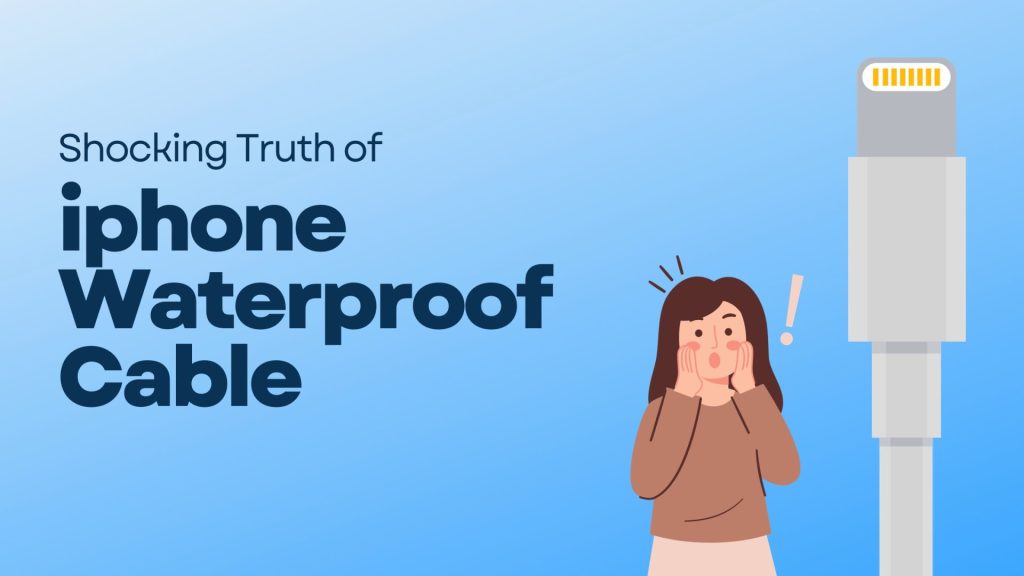Newer iPhone models like iPhone XS, XS Max, XR, and later versions have a feature that can display a liquid-detection alert when you connect a Lightning or USB-C cable or an accessory, warning you if there’s liquid present in the connector.
If your iPhone displays a liquid-detection alert, it means the Lightning or USB-C connector, cable ends, or accessory has been detected with liquid.
To safeguard your iPhone and the accessory, charging, and connection won’t be possible until the connector, cable ends, and accessory are completely dry.
You are also excited the know, Is the iPhone charging cable is waterproof.
Is the iPhone charger getting wet?
The iPhone charging port can be exposed to water, but it’s best to minimize contact to prevent damage.
The iPhone isn’t waterproof, and although the port has some resistance to splashes, even small amounts of liquid can cause problems.
What if the water spills on the iPhone charger?
Spilling water on your iPhone charger can have varying effects, from a minor inconvenience to causing permanent damage.
The outcome depends on factors such as the severity of the spill, the type of charger, immediate action taken, and the potential consequences.
Is the Apple USB-C cable waterproof?
The Apple USB-C cables, including those bundled with newer iPhones, aren’t waterproof.
Although their connectors might offer slight splash resistance, they’re not built to endure submersion or extended contact with liquids.
How can water damage an Apple charger?
Accidentally spilling water on your reliable Apple charger, be it the classic Lightning cable or the newer USB-C can cause concern.
Despite their apparent durability, these cables aren’t built to withstand water exposure, and even a small splash can result in issues.
How to dry iPhone charging cable?
Here’s a summarized guide on drying a wet iPhone charging cable effectively for a US audience:
1. Immediate Actions:
Unplug the cable from the power outlet and iPhone to prevent further water entry.
Gently shake the cable to remove surface water without forcing it deeper.
2. Drying Techniques:
Use a clean, lint-free cloth to wipe the cable dry, avoiding rough materials.
Air-dry the cable in a well-ventilated area at room temperature for at least 24 hours. Avoid direct sunlight or heat sources.
3. Post-Drying Checks:
Visually inspect for damage like corrosion, cracks, or frayed wires. Discard if found.
Test the cable by reconnecting it to power and your iPhone. If it charges normally, it’s likely safe. Replace if there are issues.
Additional Tips:
1. Keep a spare cable for emergencies and consider waterproof options for added durability.
2. Monitor the dried cable for any signs of malfunction like overheating or unusual behavior.
3. Remember, safety is paramount, and if you notice ongoing issues or damage, it’s best to replace the cable for optimal performance and safety.

Is phone 12 water resistance?
For your US audience, the iPhone 12 has an IP68 water resistance rating, but it’s not exactly waterproof.
Is the iPhone 14 charging port waterproof?
The iPhone 14 charging port, like all iPhone ports, isn’t waterproof.
Although the iPhone 14 itself holds an IP68 water resistance rating, this rating exclusively applies to the phone and doesn’t cover the charging port’s waterproofing.
Can water damage an Apple charger?
Accidentally spilling water on your Apple charger, whether it’s the classic Lightning cable or the newer USB-C, can cause significant problems.
Despite their appearance of sturdiness, these chargers aren’t waterproof, and even a small splash can result in significant issues for users in the US.
Can the iPhone detect moisture in the charging port?
Phones from the XS model onwards possess the capability to detect moisture in their charging ports.
This feature acts as an additional safeguard for the device, serving to mitigate potential water damage.
Can I use a hair dryer to dry my iPhone charging port?
Avoid using a hair dryer to dry your iPhone’s charging port at all costs.
Despite the temptation to act fast, using a hair dryer can be risky and might exacerbate the damage caused by water exposure rather than alleviate it.
How can you tell if your iPhone charger port is water-damaged?
Detecting water damage in your iPhone charger port involves several signs:
1. Visual Clues:
Corrosion, rust, or unusual deposits indicate moisture exposure.
Debris, discoloration, or physical damage can suggest water infiltration.
2. Functional Issues:
Charging problems, overheating, data transfer issues, and iPhone alerts like liquid detection messages are red flags for water damage.
Remember:
1. Even without immediate signs, water damage can lead to future issues.
2. If suspected, seek evaluation and repair from an Apple Store or authorized service provider.
3. Prevention includes avoiding water exposure, thorough drying if wet, and using waterproof cases, and certified chargers for your iPhone model.
How long does it take for water to dry out of the iPhone charging port?
The time it takes for water to dry out of your iPhone charging port varies based on factors like water quantity, humidity, air circulation, and temperature.
1. Small splashes or condensation in dry conditions might evaporate in 30 minutes to an hour.
2. Moderate spills may take several hours or overnight to dry fully.
3. Submersion, even briefly, could require 24 hours or longer to dry, even in ideal conditions
Key points to remember:
1. Air drying is safest; avoid using heat sources or rushing the process.
2. Patience is crucial to prevent potential short-circuiting from a damp port.
3. Monitor for unusual behavior like overheating or connection issues, indicating lingering water damage needing professional evaluation.
Cost to fix a water-damaged iPhone charging port?
Repairing a water-damaged iPhone charging port’s cost depends on factors like the iPhone model, damage severity, repair provider, and location:
1. Simple cleaning or minor repairs may cost $50-$100.
2. Moderate damage repairs could range from $100-$200.
3. Extensive damage might cost $200-$500+
Key points to note:
1. Costs vary based on the model, damage extent, repair provider, and location.
2. Extensive damage might render the phone irreparable, necessitating a new purchase.
3. Always obtain repair estimates beforehand.
Additional options include DIY repair (risky, could void warranty) or considering trade-in/selling for a new model if repair costs are high or the phone is older.
List of Best iPhone, iPad waterproof charging cable
Here are some of the best iPhone, and iPad waterproof charging cables.
Rokk: The new ROKK Lightning charging cable offers:
1. Length options of 0.6m or 2m for USB and iPad/iPhone/iPod connections.
2. Robust Lightning and USB ports are designed for extreme conditions.
3. Ideal for outdoor activities like water sports, sailing, and camping.
4. Officially tested by Apple for iPhone, iPad, and iPod use.
5. 100% waterproof with special protective varnish on plugs to prevent rust.
6. Compatibility with all iPad and iPhone cases featuring a charging socket.
Armilo bracelet wearable charger
Armilo’s wearable charger is a leather bracelet that conceals a powerful charging cable within its stylish design.
The bracelet seamlessly integrates a charging jack and USB, creating a fashionable metal pendant with a magnet.
This wearable bracelet charger, featuring a Type C connection, ensures your phone stays charged while occupying minimal space in your bag.
Some of the other lists are here: link
Which things do not do for drying?
Avoid drying your iPhone using external heat sources or compressed air.
Also, refrain from inserting foreign objects like cotton swabs or towels into the connector.
Additionally, do not place your iPhone in a bag of rice as rice particles could potentially harm the device
A final thought on iPhone charger wet cables
Charging your iPhone with a wet Lightning or USB-C connector can lead to pin corrosion and permanent damage or connectivity issues.
Though it’s not recommended, in emergencies, you can override the liquid detection to charge your iPhone with a wet connector.
Alternatively, using a wireless charger is a safe option. Ensure the back of your iPhone is dry for optimal charging on a Qi-certified wireless charger.
